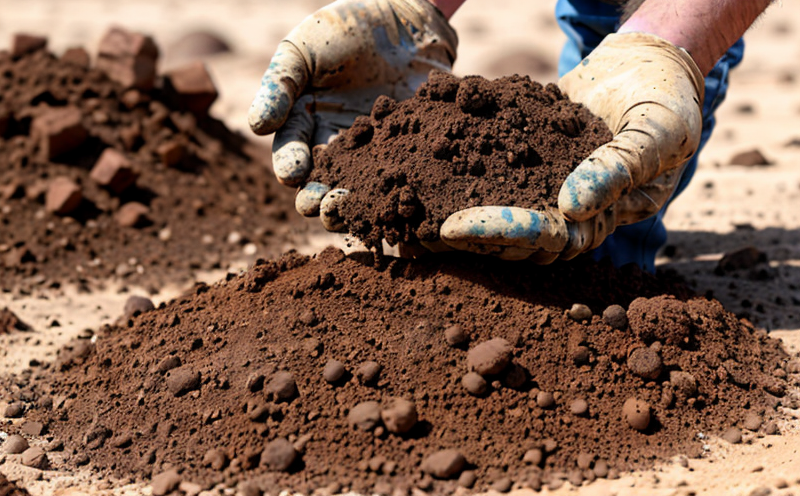ASTM D422 Particle Size Analysis by Hydrometer Testing
In the mining sector, accurate characterization of soil and overburden is critical for successful project planning and execution. The particle size distribution (PSD) analysis plays a pivotal role in ensuring that materials meet design specifications and performance requirements.
The ASTM D422 standard provides a robust method for determining the particle size distribution of fine mineral or rock particles by hydrometer testing. This service is particularly valuable when dealing with materials such as soil, overburden, or finely crushed minerals where understanding the particle size distribution can significantly impact processing efficiency and product quality.
The process involves measuring the sedimentation rates of particles in a suspension medium (usually water). Particles settle at different rates depending on their size, allowing for the calculation of cumulative percentages of various particle sizes. This information is crucial for optimizing extraction processes, designing effective dewatering systems, and predicting the behavior of materials during transportation.
Hydrometer testing is an economical and straightforward method compared to more complex sieve analysis techniques used in some other industries. It allows for quick assessments of material characteristics without extensive preparation or sophisticated equipment. However, it should be noted that this technique has limitations when dealing with very fine particles (below 75 microns) as it can sometimes yield less precise results than other methods.
For accurate and reliable PSD data, proper sample preparation is essential. Samples must be thoroughly dried to constant weight before being ground into a fine powder using standard procedures. The resulting suspension should have a uniform consistency throughout the volume of water used for testing. Careful attention to detail during this phase ensures consistent results across multiple tests.
After preparing the sample, it is poured slowly onto the surface of still water in graduated cylinders or beakers. As particles settle, their rates are observed and recorded over time intervals specified by ASTM D422. Calculations based on these measurements yield the cumulative percentage retained on each size fraction.
Interpreting the results involves plotting the cumulative percentages against corresponding particle sizes to generate a curve that represents the particle size distribution of the sample. This graphical representation helps identify key characteristics like median diameter, effective size, and uniformity coefficient which are important parameters for decision-making within mining operations.
The reliability of hydrometer testing lies in its ability to provide consistent results when performed correctly according to established protocols. By adhering strictly to ASTM D422 guidelines, laboratories can ensure that their findings contribute valuable insights into material properties while maintaining high standards of accuracy and repeatability.
Applied Standards
The ASTM D422 standard specifies the procedures for determining particle size distributions using hydrometer testing. This method is widely accepted across various industries including mining, construction, and environmental science due to its simplicity and effectiveness in providing reliable data on particle sizes.
Some key aspects of this standard include:
- Sampling procedures ensuring representative samples are collected from the material being tested.
- Preparation methods to ensure uniformity and stability of the suspension medium used during testing.
- Calibration requirements for hydrometers to guarantee accurate measurement of particle settling rates.
Quality and Reliability Assurance
To maintain high levels of quality and reliability in ASTM D422 testing, several measures are implemented:
- Calibration: Ensuring all hydrometers used meet the required accuracy specifications before each test.
- Sampling: Strict adherence to ASTM D422 sampling protocols to obtain representative samples from the material under study.
- Data Recording: Comprehensive documentation of every step in the testing process, including environmental conditions and observed particle settling rates.
The use of advanced analytical software can further enhance reliability by automating calculations and comparisons against industry benchmarks. Regular calibration checks and proficiency tests also play crucial roles in maintaining consistent performance levels among different facilities performing this type of analysis.
Customer Impact and Satisfaction
Accurate particle size distribution data provided through ASTM D422 testing has direct implications on customer satisfaction within the mining industry. By ensuring that materials meet specified criteria, this service contributes to:
- Optimized Production Processes: Understanding how different particle sizes behave allows for better control over extraction rates and reduction of waste.
- Better Product Quality: Consistent results help in maintaining the desired quality standards across all products manufactured from these raw materials.
- Environmental Compliance: Knowing precisely what you're working with helps adhere to environmental regulations regarding emissions and effluent discharge.





